Hytera Communications TC-508V Two-way Radio User Manual 8913A TC508 Owner s Manual V00
Hytera Communications Corporation Ltd. Two-way Radio 8913A TC508 Owner s Manual V00
Users Manual
Preface
Thank you for purchasing Hytera TC-508 portable radio. With simple appearance, reliable mechanics,
practical functions and stable performance, it will refresh your communication experience!
To derive optimum performance from your product, please read this manual and the supplied Safety
Information Booklet carefully before use.

TC-508V Owner’s Manual
1
Instructional Icons
The following icons are available through this manual:
Caution: indicates situations that could cause damage to your radio.
Note: indicates tips that can help you make better use of your radio.
Term Explanation
Please pay your attention to the following key terms:
Key Operation
Short press: to press a key and release it quickly.
Long press: to press and hold down a key for above 1 second.
Hold down: to press a key and remain holding it down.
User Mode
Refers to the mode entered after you turn on the radio directly.
CTCSS/CDCSS
The signaling can help you prevent unwanted conversations at the same frequency.

2
Copyright Information
Hytera and HYT are trademarks or registered trademarks of Hytera Communications Co., Ltd. (“Hytera”)
in PRC and/or other countries or areas. Hytera retains the ownership of its trademarks and product
names. All other trademarks and/or product names that may be used in this manual are properties of
their respective owners.
The Hytera product described in this manual may include Hytera computer programs stored in memory
or other media. Laws in PRC and/or other countries or areas protect the exclusive rights of Hytera with
respect to its computer programs. The purchase of this product shall not be deemed to grant, either
directly or by implication, any rights to the purchaser regarding Hytera computer programs. Any Hytera
computer programs may not be copied, modified, distributed, decompiled, or reverse-engineered in any
manner without the prior written consent of Hytera.
Disclaimer
Hytera endeavors to achieve the accuracy and completeness of this manual, but no warranty of
accuracy or reliability is given. All the specifications and designs are subject to change without prior
notice due to continuous technology development. No part of this manual may be copied, modified,
translated, or distributed in any manner without the express written permission of Hytera.
If you have any suggestions or would like to learn more details, please visit our website at:
http://www.hytera.cn.
RF ENERGY EXPOSURE AWARENESS AND CONTROL INFORMATION,
AND OPERATIONAL INSTRUCTIONS FOR FCC OCCUPATIONAL USE
REQUIREMENTS
BEFORE USING YOUR PORTABLE 2-WAY RADIO, READ THIS IMPORTANT RF
ENERGY AWARENESS AND CONTROL INFORMATION AND OPERATIONAL
INSTRUCTIONS TO ENSURE COMPLIANCE WITH THE FCC’S RF EXPOSURE
GUIDELINES
NOTICE: This radio is intended for use in occupational/controlled conditions, where users
have full knowledge of their exposure and can exercise control over their exposure to meet
FCC limits. This radio device is NOT authorized for general population, consumer, or any
other use.
TC-508V Owner’s Manual

3
This 2-way radio uses electromagnetic energy in the radio frequency (RF) spectrum to provide
communications between two or more users over a distance. It uses radio frequency (RF) energy
or radio waves to send and receive calls. RF energy is one form of electromagnetic energy.
Other forms include, but are not limited to, electric power, sunlight and x-rays. RF energy,
however, should not be confused with these other forms of electromagnetic energy, which when
used improperly can cause biological damage. Very high levels of x-rays, for example, can
damage tissues and genetic material.
Experts in science, engineering, medicine, health and industry work with organizations to develop
standards for exposure to RF energy. These standards provide recommended levels of RF
exposure for both workers and the general public. These recommended RF exposure levels include
substantial margins of protection. All 2-way radios marketed in North America are designed,
manufactured and tested to ensure they meet government established RF exposure levels. In
addition, manufacturers also recommend specific operating instructions to users of 2-way radios.
These instructions are important because they inform users about RF energy exposure and provide
simple procedures on how to control it. Please refer to the following websites for more
information on what RF energy exposure is and how to control your exposure to assure
compliance with established RF exposure limits.
http://www.fcc.gov/oet/rfsafety/rf-faqs.html
http://www.osha.gov/SLTC/radiofrequencyradiation/index.html
Federal Communications Commission Regulations
The FCC rules require manufacturers to comply with the FCC RF energy exposure limits for
portable 2-way radios before they can be marketed in the U.S. When 2-way radios are used as a
consequence of employment, the FCC requires users to be fully aware of and able to control their
exposure to meet occupational requirements. Exposure awareness can be facilitated by the use of
a product label directing users to specific user awareness information. Hytera’s 2-way radio has a
RF exposure product label. Also, Hytera’s user manual, or product manual, or separate safety
booklet includes information and operating instructions required to control your RF exposure and
to satisfy compliance requirements.
This device complies with part 15 of the FCC Rules. Operation is subject to the following two
conditions: (1) This device may not cause harmful interference, and (2) this device must accept
any interference received, including interference that may cause undesired operation.
Any Changes or modifications not expressly approved by the party responsible for compliance
could void the user's authority to operate the equipment.
Compliance with RF Exposure Standards
Hytera’s 2-way radio is designed and tested to comply with a number of national and international
standards and guidelines (listed below) for human exposure to radio frequency electromagnetic
energy. This radio complies with the IEEE and ICNIRP exposure limits for
occupational/controlled RF exposure environment at operating duty factors of up to 50%
TC-508V Owner’s Manual

4
transmitting and is authorized by the FCC for occupational use only. In terms of measuring RF
energy for compliance with the FCC exposure guidelines, your radio radiates measurable RF
energy only while it is transmitting (during talking), not when it is receiving (listening) or in
standby mode. Note: The approved batteries supplied with this radio are rated for a 5-5-90 duty
factor (5% talk-5% listen - 90% standby), even though this radio complies with the FCC
occupational RF exposure limits and may operate at duty factors of up to 50 % talk.
Hytera’s 2-way radio complies with the following RF energy exposure standards and guidelines:
• United States Federal Communications Commission, Code of Federal Regulations; 47 CFR §§
1.1307, 1.1310, 2.1091 and 2.1093
• American National Standards Institute (ANSI) / Institute of Electrical and Electronic Engineers
(IEEE) C95. 1-1992
• Institute of Electrical and Electronic Engineers (IEEE) C95.1-1999 Edition
RF Exposure Compliance and Control Guidelines and Operating Instructions
To control your exposure and ensure compliance with the occupational/controlled environment
exposure limits always adhere to the following procedures.
Guidelines:
• Do not remove the RF Exposure Label from the device.
• User awareness instructions should accompany device when transferred to other users.
• Do not use this device if the operational requirements described herein are not met.
Operating Instructions:
• Transmit no more than the rated duty factor of 50 % of the time. To transmit (talk), push the
Push-To-Talk (PTT) button. To receive calls, release the PTT button. Transmitting 50 % of the
time, or less, is important because this radio generates measurable RF energy exposure only when
transmitting (in terms of measuring for standards compliance).
• Hold the radio in a vertical position in front of face with the microphone (and the other parts of
the radio, including the antenna) at least one inch (2.5 cm) away from the nose. Keeping the
radio at the proper distance is important because RF exposures decrease with distance from the
antenna. Antenna should be kept away from eyes.
• When worn on the body, always place the radio in a Hytera’s approved clip, holder, holster, case,
or body harness for this product. Using approved body-worn accessories is important because the
use of Hytera’s or other manufacturer’s non-approved accessories may result in exposure levels,
which exceed the FCC’s occupational/controlled environment RF exposure limits.
• If you are not using a body-worn accessory and are not using the radio in the intended use
position in front of the face, then ensure the antenna and the radio are kept at least 2.5 cm (one
inch) from the body when transmitting. Keeping the radio at the proper distance is important
because RF exposures decrease with increasing distance from the antenna.
• Use only manufacturer’s name approved supplied or replacement antennas, batteries, and
accessories. Use of non-manufacturer-name approved antennas, batteries, and accessories may
exceed the FCC RF exposure guidelines.
• For a list of Hytera’s approved accessories (see the user manual), or (visit the following website
which lists approved accessories: www.hytera.cn
TC-508V Owner’s Manual

5
Operational Instructions and Training Guidelines
● Gain of antenna must not exceed 3.0dBi.
● Under Industry Canada regulations, this radio transmitter may only operate using an antenna
of a type and maximum (or lesser) gain approved for the transmitter by Industry Canada. To
reduce potential radio interference to other users, the antenna type and its gain should be so
chosen that the equivalent isotropically radiated power (e.i.r.p.) is not more than that
necessary for successful communication
● This radio transmitter (IC: 8913A-TC508V) has been approved by Industry Canada to
operate with the antenna types listed below with the maximum permissible gain and required
antenna impedance for each antenna type indicated. Antenna types not included in this list,
having a gain greater than the maximum gain indicated for that type, are strictly prohibited for
use with this device
● The device complies with SAR and/or RF field strength limits of RSS-102 requirement.
CANADIAN REPRESENTATIVE Information:
Company Name: OMNI PROVINCIAL ELECTRONICS ONTARIO INC.
Address: 1211 Gorham Street Unit 3 New Market Ontario L4C 9S7 Canada
ICsatatement
Operationissubjecttothefollowingtwoconditions:1.Thisdevicemaynotcauseharmful
interference,and2.Thisdevicemustacceptanyinterferencereceived,includinginterference
thatmaycauseundesiredoperation.
Note:Changesormodificationstothisunitnotexpresslyapprovedbythepartyresponsiblefor
compliancecouldvoidtheuser'sauthoritytooperatetheequipment
EU Regulatory Conformance
The product is in compliance with the essential requirements and other relevant provisions of the
Directive 1999/5/EC.
Note: The above information is applicable to EU countries only.
The radio is not intended for use by general population in an uncontrolled environment. It
is only for occupational use and only applied to work-related conditions.The radio must be
only used by users, who are fully aware of the hazards of the exposure and who are able
to exercise control over their RF exposure to qualify for the higher exposure limits.
TC-508V Owner’s Manual

6
Contents
Checking Items in the Package ................................................................................................................ 6
Product Overview ..................................................................................................................................... 7
Product Controls ............................................................................................................................... 7
Programmable Keys .......................................................................................................................... 8
Before Use ............................................................................................................................................... 9
Charging the Battery ......................................................................................................................... 9
Assembling the Accessories ............................................................................................................ 10
Status Indication ..................................................................................................................................... 12
Basic Operations .................................................................................................................................... 13
Turning the Radio On/Off ................................................................................................................ 13
Adjusting the Volume ...................................................................................................................... 13
Selecting a Channel ........................................................................................................................ 13
Transmitting / Receiving .................................................................................................................. 13
Functions and Operations ...................................................................................................................... 14
CTCSS/CDCSS .............................................................................................................................. 14
Time-out Timer (TOT) ...................................................................................................................... 14
Adjust Power Level.......................................................................................................................... 14
Monitor ............................................................................................................................................ 14
Squelch Off ..................................................................................................................................... 15
Scan ................................................................................................................................................ 15
VOX ................................................................................................................................................. 16
Battery Strength Indicator ................................................................................................................ 17
Low Battery Alert ............................................................................................................................. 17
Channel Lock ..................................................................................................................................
17
Battery Save .................................................................................................................................... 18
Busy Channel Lockout .................................................................................................................... 18
Troubleshooting ...................................................................................................................................... 19
Care and Cleaning ................................................................................................................................. 21
TC-508V Owner’s Manual
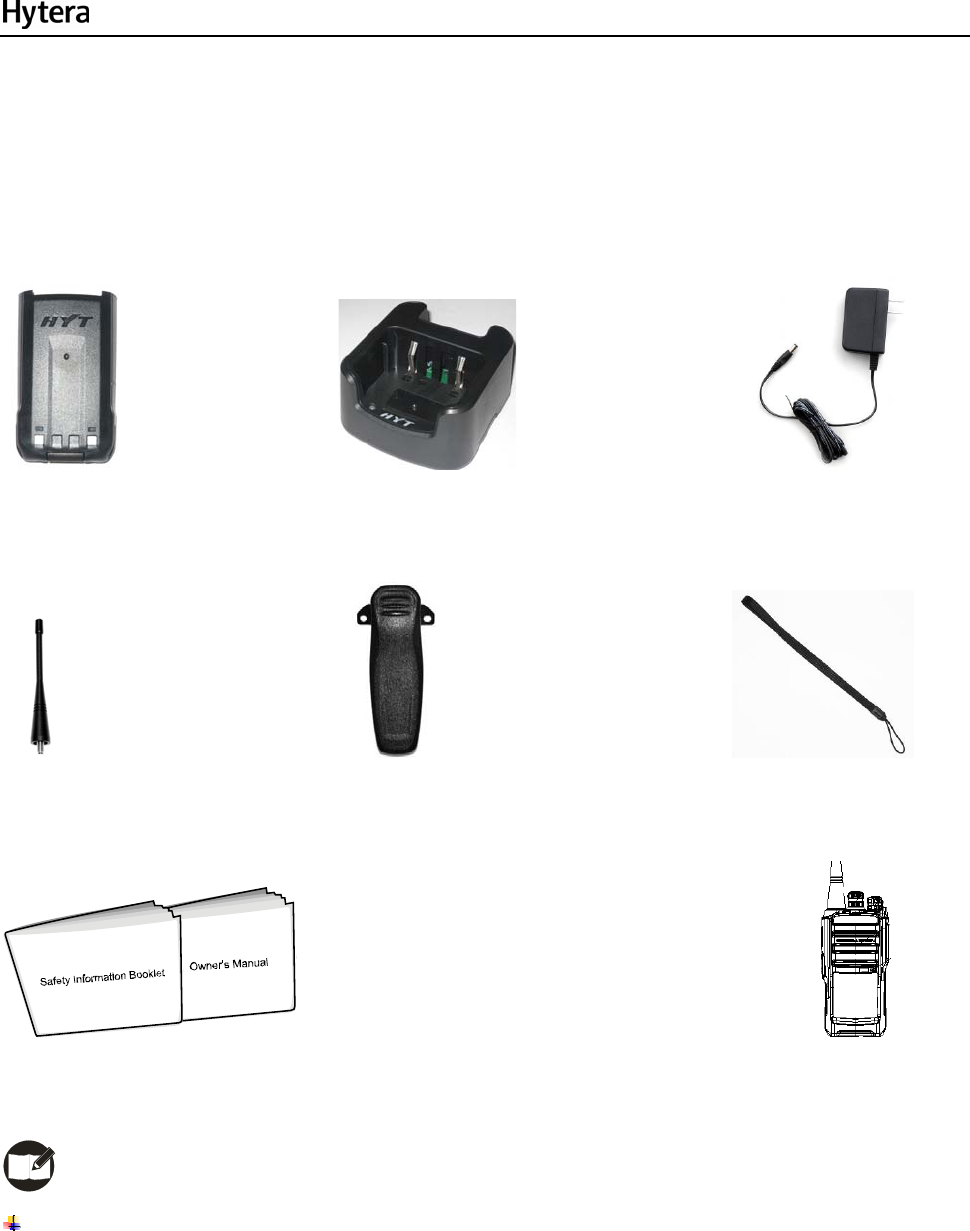
7
Checking Items in the Package
Please unpack carefully and check that all items listed below are received. If any item is missing or
damaged, please contact your dealer.
Battery Rapid-rate Charger (for Li-Ion battery) Power Adapter
Antenna Belt Clip Strap
Manuals Radio
Note:
The pictures above are for reference only.
TC-508V Owner’s Manual
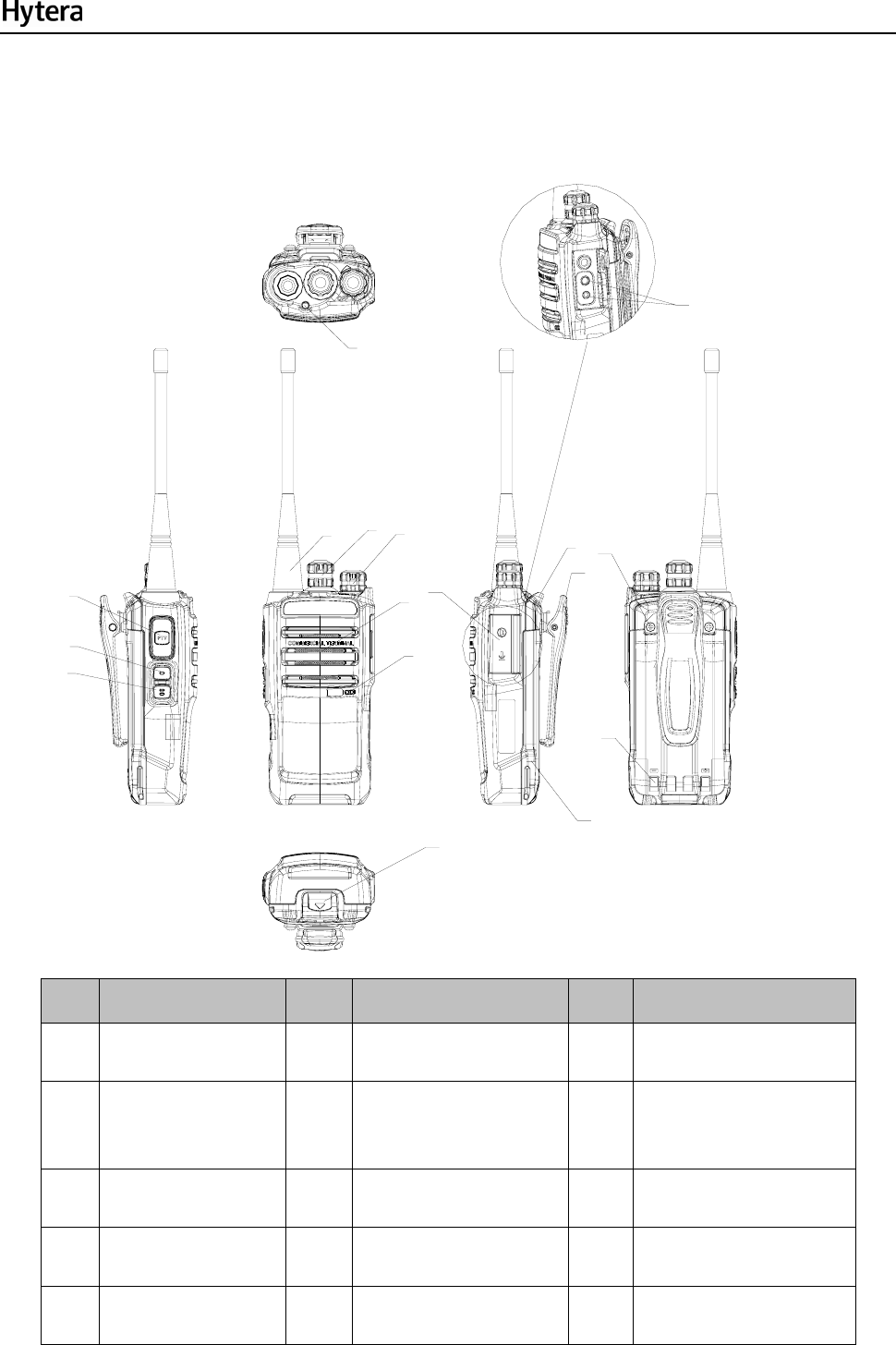
8
Product Overview
Product Controls
10
9
3
2
1
17
16
15
14
11
8
7
456
13
12
No. Part Name No. Part Name No. Part Name
○
1 PTT Key ○
2 SK1 (programmable) ○
3 SK2 (programmable)
○
4 Antenna ○
5 Channel Selector Knob ○
6 Radio On-Off/Volume
Control Knob
○
7 Speaker ○
8 Microphone ○
9 LED Indicator
○
10 Battery Latch ○
11 Accessory Jack Cover ○
12 Accessory Jack
○
13 Strap Hole ○
14 Belt Clip ○
15 Battery
TC-508V Owner’s Manual

9
○
16 Screw (Belt Clip) ○
17 Charging Piece
Programmable Keys
For enhanced convenience, you may request your dealer to program the keys SK1 and SK2 as
shortcuts to the functions listed below:
No. Shortcut Key Function
1 Adjust Power Level To adjust power level through one button
press.
2 Monitor To adjust the condition for incoming signal
match
3 Monitor Momentary
4 Squelch Off To always unmute speaker no matter
whether carrier is present or not
5 Squelch Off Momentary
6 Scan To listen to communication activities on
other channels.
7 VOX To make the radio transmit automatically
when you speak.
8 Battery Strength Indicator To indicate the battery strength
9 Channel Lock
The current channel will remain unchanged
in case of rotating the Channel Selector
knob accidentally.
Note: Long and short press of a key can be assigned with different functions by your dealer.
TC-508V Owner’s Manual
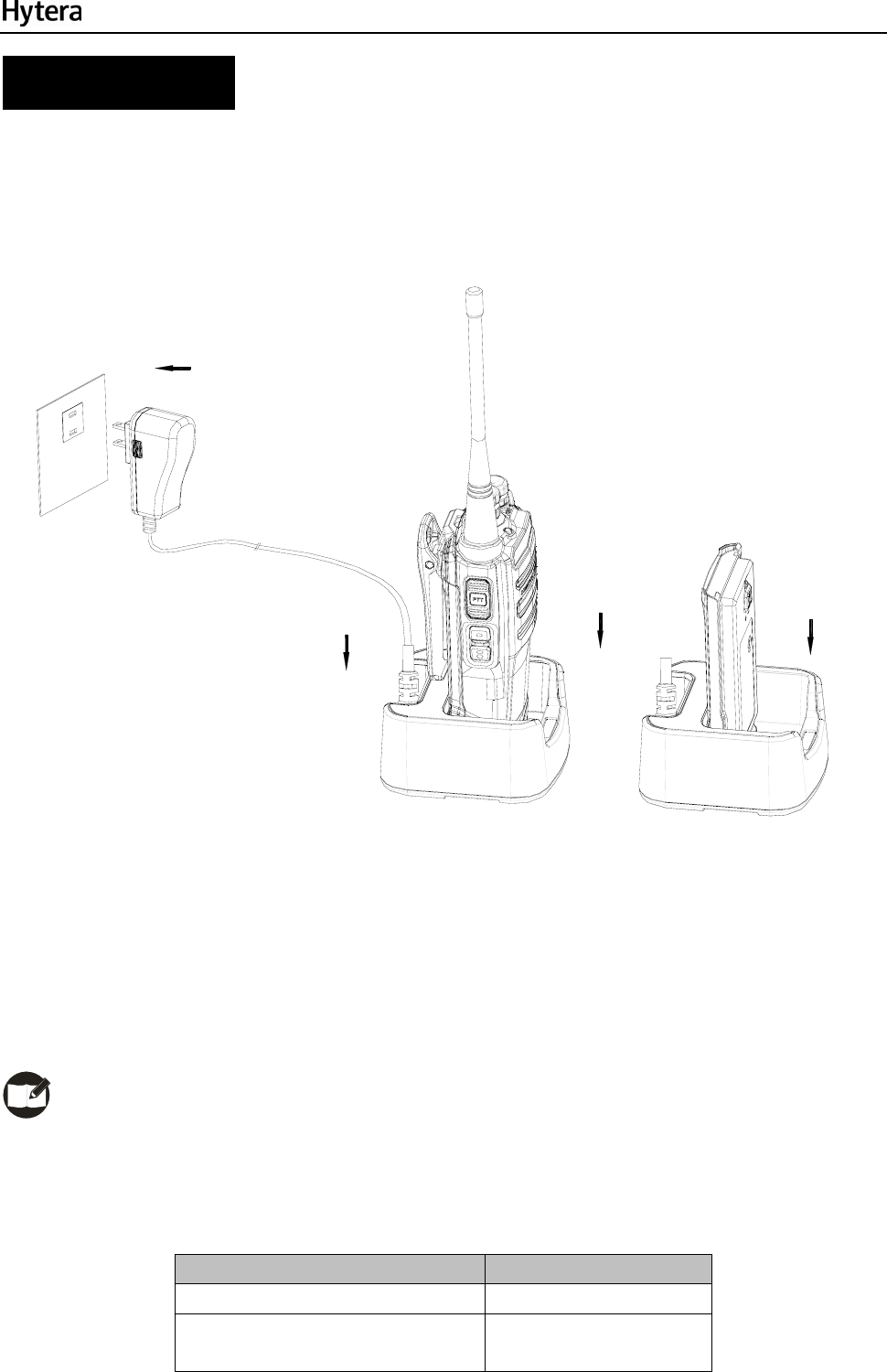
10
Before Use
Charging the Battery
Use only the charger and battery specified by Hytera. Charger LED can indicate the charging process.
■ Charge Diagram
3
3
2
1
■ Procedures
1. Connect the power adapter to AC socket. See arrow 1.
2. Plug the power adapter into the rear jack of the charger. See arrow 2.
3. Place the radio with the battery attached, or the battery alone, into the charger. See arrow 3.
4. The charging process initiates when LED glows red, and is completed when LED glows green.
Note: To achieve optimal battery performance, please charge the battery for 5 hours before initial
use.
Charge Indicator
LED Indicator Charge Status
Red LED glows. Charging
Orange LED glows. Approximately charged
completely
TC-508V Owner’s Manual
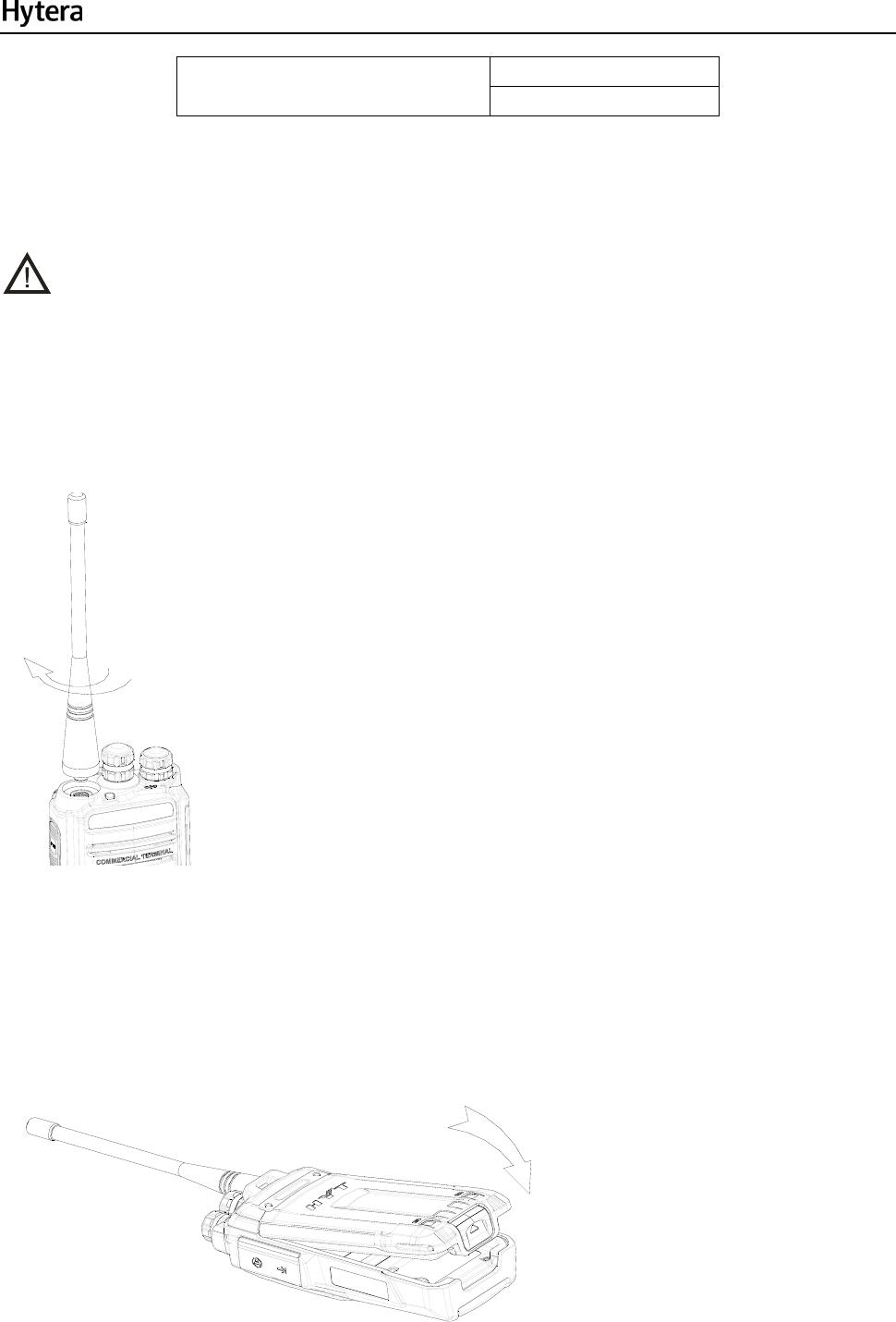
11
Green LED glows. Fully charged
Ready for use
When battery power runs low, the LED will flash red, and the low-pitched tone will sound periodically. In
this case, please replace or charge the battery.
Caution: Be sure to read the Safety Information Booklet, to get necessary safety information.
Assembling the Accessories
Assembling the Antenna
Turn the antenna clockwise to fasten it.
To remove the antenna, rotate it counter-clockwise.
Assembling the Battery
1. Slide the battery into the radio’s slot.
2. Slightly press the bottom of the battery until a click is heard.
To remove the battery, turn off the radio first. Slide the battery latch upward to release the battery.
TC-508V Owner’s Manual
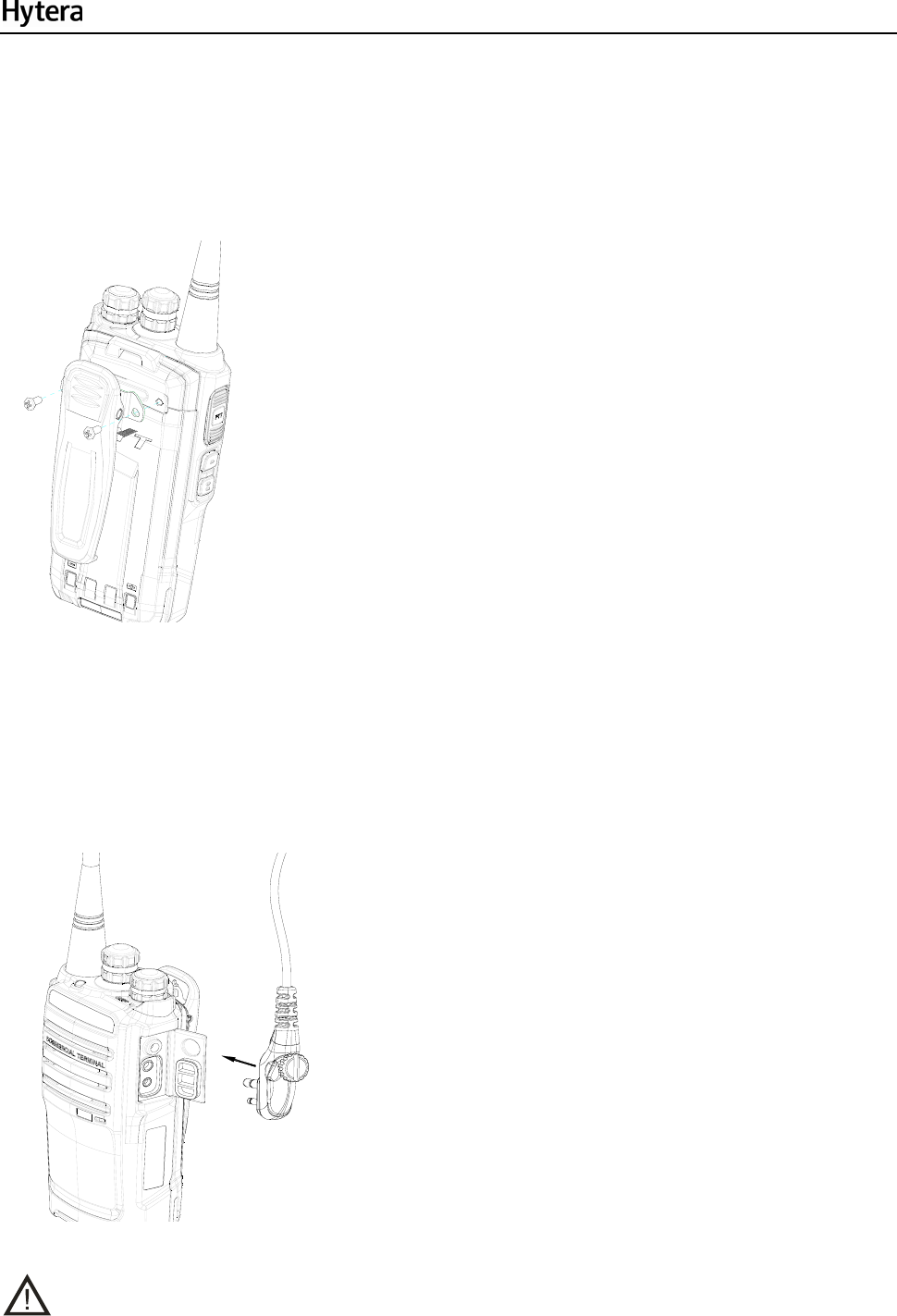
12
Assembling the Belt Clip
1. Remove the screws.
2. Align the screw holes on the belt clip with those on the radio’s body, and then tighten the screws.
To remove the belt clip, loosen the screws.
Assembling the Audio Accessory/Programming Cable
1. Uncover the accessory jack.
2. Plug an audio accessory/programming cable into the accessory jack, and then tighten the screw.
To remove the accessories, loosen the screw at first and pull out the plug.
Caution: When you are using an external accessory, waterproof performance of the radio may
get affected.
TC-508V Owner’s Manual
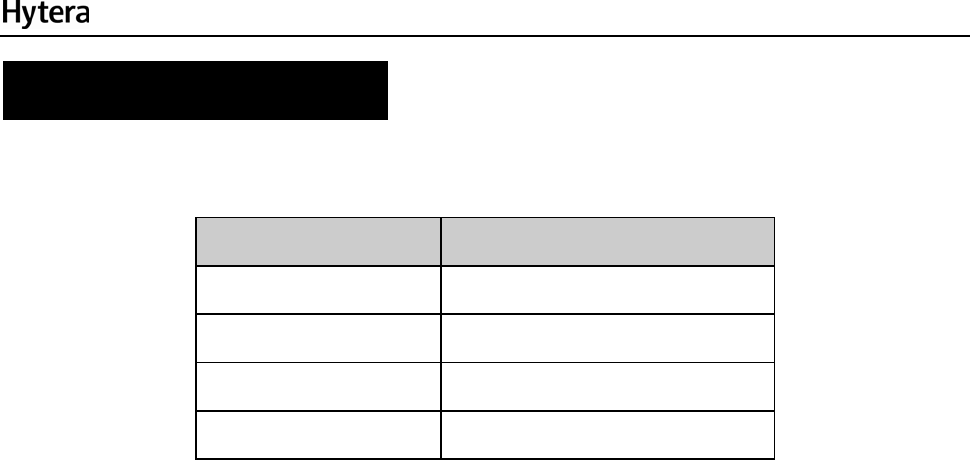
13
Status Indication
The top LED indicator will help you easily identify the current status of your radio.
LED Indicator Radio Status
Red LED glows. Transmitting
Red LED flashes. Low battery alert
Green LED glows. Receiving
Green LED flashes. Scanning
TC-508V Owner’s Manual

14
Basic Operations
Turning the Radio On/Off
Rotate the Radio On-Off/Volume Control knob clockwise/counter-clockwise until a click is heard to turn
the radio on/off.
Adjusting the Volume
You may control the volume level using the Radio On-Off/Volume Control knob. After the radio is
powered on, rotate the knob clockwise to increase the volume, or counter-clockwise to decrease the
volume.
Selecting a Channel
The radio supports up to 16 channels. Rotate the Channel Selector knob to align your desired channel
number with the white channel mark.
Note: When the radio is currently on a blank channel, it will sound beep tones continuously.
Transmitting / Receiving
To transmit audio signals, press and hold down the PTT, and speak into the microphone. During
transmission, the LED glows red.
To receive, just release the PTT. When any audio signal is received, the LED glows green.
Note:
To ensure optimal volume of the receiving radio, hold the radio approximately 2.5 to 5
centimeters away from your mouth.
Communication range may get affected in rainy days or forest locations.
TC-508V Owner’s Manual

15
Functions and Operations
CTCSS/CDCSS
CDCSS/CTCSS can be used to prevent unwanted conversations at the same frequency. If
CTCSS/CDCSS is set on a certain channel, you can only receive voice calls from radios with matching
CTCSS/CDCSS. Otherwise you will receive voice calls from all users operating at the same frequency.
You may request your dealer to program corresponding parameters on certain channels. For detailed
operation method, please consult your dealer.
Time-out Timer (TOT)
The purpose of TOT is to prevent any user from occupying a channel for an extended period. When the
preset time expires, the radio will automatically terminate transmission and keep beeping. To stop
beeping, please release the PTT key. You must wait for a certain time period (preset by your dealer) to
initiate another transmission.
If the pre-alert function is set by your dealer, your radio will alert you to the TOT expiration in advance.
Adjust Power Level
With this feature, you may switch power levels quickly. Generally, we recommend you to adopt low
power for battery saving. However, if you cannot communicate with other radios located at a distant
place with low power, please select high power.
Operation:
Press the programmed Adjust Power Level key to switch between high power and low power (from
high power to low power: a low-pitched tone sounds; from low power to high power: a high-pitched
tone sounds).
Monitor
This feature allows you to lower the conditions for incoming signal match.
Operation:
Press the programmed Monitor key to activate this function (an alert tone sounds); press it
again to deactivate the function (the alert tone sounds twice). Or
TC-508V Owner’s Manual

16
Press and hold down the programmed Monitor Momentary key to activate this function (an
alert tone sounds); release the key to exit (the alert tone sounds twice).
Squelch Off
This feature allows you to always unmute the speaker, no matter whether carrier is present or not.
Operation:
Press the programmed Squelch Off key to activate this function; press the key again to
deactivate it. Or
Press and hold down the programmed Squelch Off Momentary key to activate this function;
release the key to deactivate it.
Note: When this function is enabled on current channel, you will hear audio signals (if any);
otherwise, background noise will be heard.
Scan
The feature allows you to listen to communication activities on other channels so that you can keep a
close track of your team members. The scan list can be set by your dealer.
Operation:
1. To activate this function, you may
press the programmed Scan key; or
switch to a channel enabled with the auto scan feature (programmed by your dealer).
Note: The radio will not start scan if there are less than two channels in the scan list.
2. After the feature is enabled, your radio will scan according to the scan list set for the channel on
which scanning starts. The scanning process is as follows:
The LED flashes green during scanning.
When communication activities are detected on a channel, the radio will stay on the channel to
receive current activities. Meanwhile, the LED glows green.
If the Talk Back feature is enabled by your dealer, press and hold down the PTT to reply when
the radio stays on a certain channel.
You can scan the frequently used channel if the priority scan feature is enabled. When scan
stays on a non-priority channel, the radio will keep detecting activities on the priority channel.
TC-508V Owner’s Manual

17
Once any activity is detected, it will jump to the priority channel. For more information, please
consult your dealer.
3. To exit the scanning process, you may
press the Scan key again, or
switch to a channel where the auto scan feature is disabled; or
turn the radio off.
Note:
The Scan Start Alert tone and the Scan End Alert tone can be enabled / disabled by the dealer.
During scanning, the following function keys (if programmed) are available: PTT, Squelch Off ,
Squelch Off Momentary , Monitor and Monitor Momentary.
VOX
This feature allows you to transmit your voice with no need to press the PTT. However, you must employ
a dedicated earpiece to realize this function.
Operation:
1. Set the PTT/VOX Switch on the earpiece to VOX;
2. Plug the earpiece into the accessory jack;
3. Press the programmed VOX key to activate this function.
4. Speak into the microphone (on the earpiece) to transmit your voice, and transmission will stop
automatically when you stop talking;
5. Power the radio off or press the VOX key again to deactivate this function.
Note:
If the PTT/VOX Switch on the earpiece is set to PTT, you can only transmit by pressing the
external PTT, no matter whether VOX is activated.
When the PTT/VOX Switch is set to PTT, you are not allowed to switch it from PTT to VOX
directly; otherwise, continuous transmission may occur. If continuous transmission occurs
unexpectedly, you can restore the radio to normal operation by toggling the switch from VOX to
PTT, or turning the radio off and back on.
You can select an appropriate VOX sensitivity according to the environment. If VOX is activated
under heavy noise, continuously transmission may occur.
TC-508V Owner’s Manual
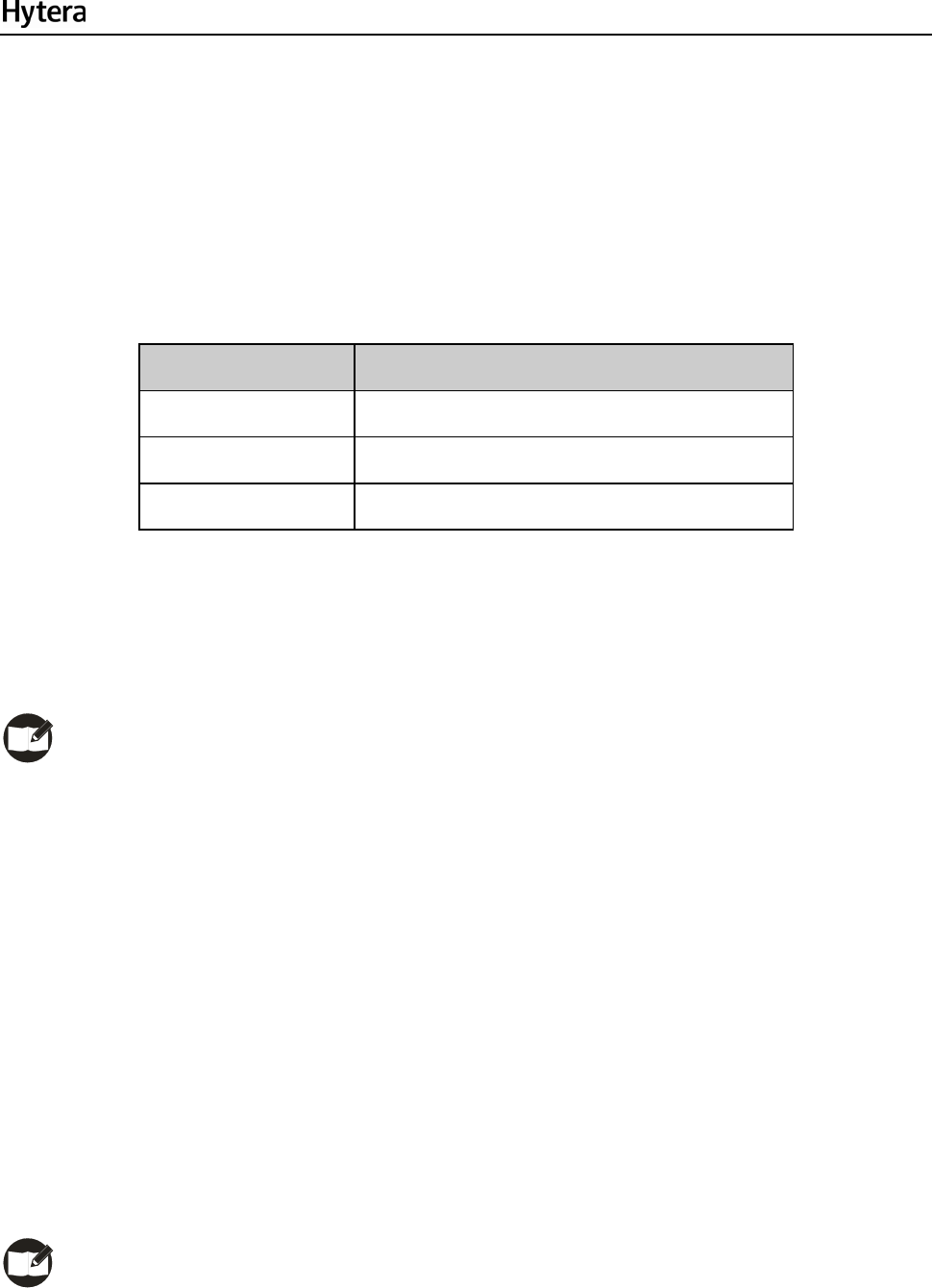
18
Battery Strength Indicator
This feature allows you to know the current battery strength.
Operation:
Press and hold down the programmed Battery Strength Indicator key, and the LED glows to
indicate remaining battery strength by different colors .Release the key to exit. The following table
lists different colors representing different battery strength levels
LED Indicator Battery Strength
Green LED glows. High
Orange LED glows. Medium
Red LED glows. Low
Low Battery Alert
This feature allows you to know the low battery status. When battery power runs low, the LED will flash
red, and the low-pitched tone will sound periodically. In this case, please replace or charge the battery.
Note: When the battery strength is insufficient, the programmed Battery Strength Indicator key
will become unavailable; when the battery strength is drained, transmission will be
prohibited; if you press PTT in such situations, the radio will sound an alert to warn you.
Channel Lock
This feature can avoid unexpected channel change due to rotation of Channel Selector knob
accidentally.
Operation:
Press the programmed Channel Lock key to enable the feature (an alert tone sounds); press the
key again to deactivate it (the alert tone sounds twice). When this function is activated, the radio will
stay on the current operating channel even if you rotate the Channel Selector knob.
Note: This function will be deactivated if the radio is powered off and back on, or it is
programmed.
TC-508V Owner’s Manual

19
Battery Save
In Standby mode, when no signal is received / transmitted or no operation (key press) is performed for
10 seconds (programmable), the radio will automatically enter Battery Save mode to reduce power
consumption. The radio may exit the Battery Save mode and get activated as soon as any key is
pressed or any signal is received.
Busy Channel Lockout
If enabled via the programming software, this feature can prevent your radio interfering with other
transmitting radios on the same channel. When the channel is already in use, the radio will keep beeping
and return to RX mode upon pressing the PTT key. To stop beeping, please release the PTT key.
TC-508V Owner’s Manual

20
Troubleshooting
Phenomena Analysis Solution
The radio can not be
powered on.
The battery may be improperly
installed. Remove the battery and attach it again.
The battery may run out. Recharge or replace the battery.
The battery may suffer from poor
contact caused by dirtied or
damaged battery contacts.
Clean the battery contacts. If the problem can
not be solved, contact your dealer or our
authorized service center for inspection and
repair.
During receiving signals, the
voice is weak, discontinuous
or totally inactive.
The battery strength may be too
low. Recharge or replace the battery.
The volume may be set to a low
level.
Increase the volume by rotating the Volume
Control knob clockwise.
The antenna may get loose or may
be improperly installed.
Power off the radio, re-install the antenna and
power on the radio again.
The speaker may be blocked or
damaged.
Clean surface of the speaker. If the problem can
not be solved, contact your dealer or our
authorized service center for inspection and
repair.
You can not communicate
with other members.
The frequency or signaling may be
inconsistent with that of other
members.
Set your TX/RX frequency and signaling to the
same as that of other members.
The Channel Lock feature is
enabled unexpectedly and you
operate on an undesired channel.
Exit the Channel Lock mode and switch to the
desired channel.
You may be too far away from the
group members.
Move towards other members. And make sure
that you are within the communication range.
Irrelevant communication
activities or noises are heard
on the channel.
You may be interrupted by radios
using the same frequency.
Change the frequency, or adjust the squelch
level.
The radio may be set with no
signaling.
Set signaling for all member radios to avoid
interference at the same frequency.
The noise is too loud.
You may be too far away from
other members.
Move towards other members, power off your
radio and then restart it.
You may be at an unfavorable
position. For example, your
communication may be blocked by
high buildings or frustrated in the
underground areas.
Move to an open and flat area, and restart the
radio.
You may suffer from external
disturbance (such as
electromagnetic interference).
Stay away from equipment that may cause
interference.
TC-508V Owner’s Manual

21
If the above solutions can not fix your problems, or you may have some other queries, please contact us
or your local dealer for more technical support.
TC-508V Owner’s Manual
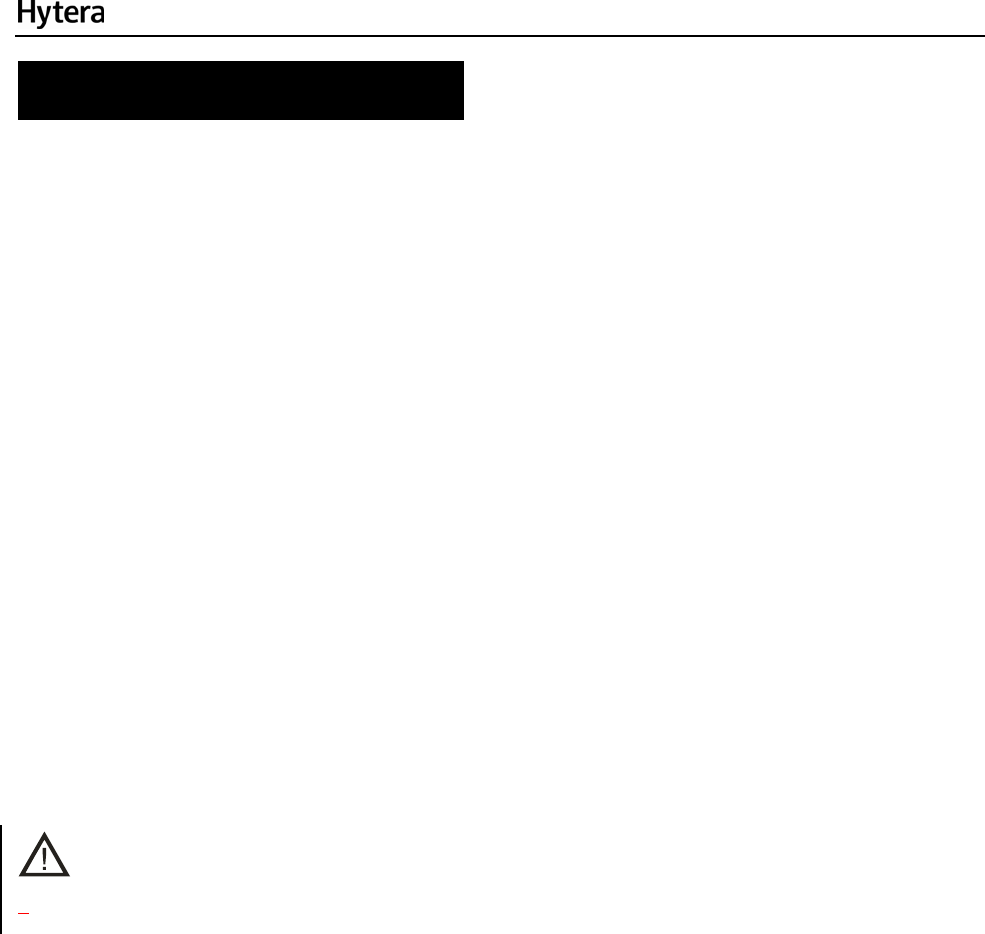
22
Care and Cleaning
To guarantee optimal performance as well as a long service life of the product, please follow the tips
below.
Product Care
Do not pierce or scrape the product with any edged instruments or hard objects.
Keep the product far away from substances that can corrode the circuit.
Do not hold the product by its antenna or earpiece cable directly.
Attach the accessory jack cover when the product is not in use.
Product Cleaning
Clean up the dust and fine particles on the product surface and charging piece with a clean and dry
lint-free cloth or a brush regularly.
Use neutral cleanser and a non-woven fabric toclean the keys, control knobs and front case after
long-time use. Do not use chemical preparations such as stain removers, alcohol, sprays or oil
preparations, so as to avoid surface case damage. Make sure the product is completely dry before
use.
Caution: Power off and remove the battery before cleaning.
TC-508V Owner’s Manual